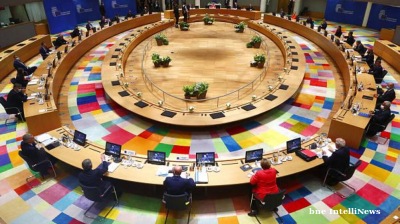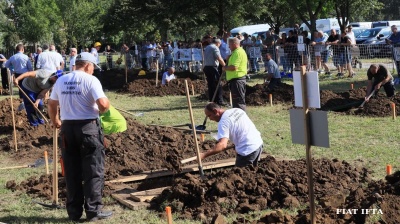 In Tobolsk's imperial heyday the Siberian city in the Tyumen region was the administrative centre for all the wilds of the taiga that stretch from Russia’s Ural mountains to the coast in Vladivostok. In those days it was a prosperous trading city that made its money from the Tsarist-era oil: furs.
In Tobolsk's imperial heyday the Siberian city in the Tyumen region was the administrative centre for all the wilds of the taiga that stretch from Russia’s Ural mountains to the coast in Vladivostok. In those days it was a prosperous trading city that made its money from the Tsarist-era oil: furs.
Founded in 1590, the city lost some of its shine in the Soviet era until the modern version of oil was discovered in western Siberia in the 1970s. The city that sits on the confluence of the Tobol and Irtysh rivers is best known to Russians as housing the prison that was home to Fyodor Dostoyevsky, the iconic Russian writer whose books became much darker after his sojourn in the squat white prison building that still sits on the main square opposite the church in the heart of the city.
Tobolsk was revived by the oil industry and it is now going through a second renaissance as it is rapidly becoming the epicentre of Russia’s burgeoning petrochemical industry. Another two hours drive from TYumen into the swampy taiga is the Sibur petrochemical plant that is in the final stages of constructing the $9bn ZapSib polymers plant that was launched in 2015 and comes online in the second quarter of next year. The plant will eventually treble the company’s output of polymers as well as doubling its revenue.
Russia is famous for its raw materials production but after almost a quarter century the economy is now moving up the value-added curve and Sibur’s ZapSib project epitomises that change.

The new ZapSib facility will come online in May 2019 and treble the company's output
Brownfields to greenfield
Russia has made most of its money exporting oil and gas and was the biggest exporter of crude in the world until October, when the US overtook it for the first time on the back of its shale revolution.
However, the process of lifting oil and gas out of the ground produces a lot of other long carbon chains that are not as immediately useful as crude oil and methane gas. Companies used to simply flare off these other products, a family of “–enes” that come up the pipeline with the more obviously sellable polymers.
Sibur’s business is to take all these other compounds, separate them out and turn them into a smorgasbord of useful products to make, among other things plastics, polymers for construction materials, as well as car bumpers and babies' nappies, amonst other things.
In the last decade Sibur has built up its production to the point where it is now a global top 10 petrochemicals-focused producer. It works with all the Russian oil and gas companies, collecting their by-products and sending them through its own 2,712km of pipelines that spread out across Western Siberia to Tobolsk for processing and then to another 22 facilities in the Russian heartland, of which Tobolsk is the biggest.
“We purchase by products from oil and gas companies – associated petroleum gases (APG) from oil companies and natural gas liquids (NGL) from gas companies – collect them from the production site, bring into one pipeline and process them into polymers and other products,” Sibur CEO Dmitry Konov told bne IntelliNews in an exclusive interview.
At the ZapSib construction site the fractional towers are already looming over the workers who are connecting the various crackers and boilers up with cocoons of pipes and pumps. Between each unit run muddy canyons where gangs of workers wander. The canopy of brightly coloured pipes gives the whole place the feeling of some sort of icy tropical forest.
“We don’t stop for the winter. The temperatures will soon fall to minus 30°C but the workers just get special clothes. We should have the mechanical construction finished on time in April,” the construction site’s foreman tells me.

Sibur took over the original petrochemical facility, a Soviet legacy plant built in the 70s, and modernised it. That plant was then extended with another larger facility to produce polymers in 2013. ZapSib is a $9bn greenfield project that uses the most modern technology and already dwarfs the other two facilities.
Sibur’s business is based on basic organic chemistry. The plant may be hugely complex but the fractional distillation and the reactions needed to make the new compounds are fairly straightforward. In essence what the company does is receive a soup of carbon compounds — polymer chains of different lengths — and separates them out into their consistent parts. Then the different chains are cooked up to make a variety of products that can be used as the feedstock for making more complex chemicals or turned into fuels and plastics granules that are used by “converters”, as Konov refers to the manufacturers that are his customers. Elastomers ( that includes synthetic rubber) is another important product that Russia has been making since Soviet times. The company details the processes in a presentation here.

To simplify: Sibur makes three main product groups: olefins and polyolefins (carbon chains with at least one double carbon bond) such as polypropylene and polyethylene, which are used to make packaging, hygiene products and other chemicals; Plastics, Elastomers and Intermediates such as the widely used synthetic rubbers or PET; and Midstream products such as liquid petroleum gases (LPGs), regular natural gas, raw natural gas liquids (NGLs) and naphtha (a flammable liquid which is used in lighter fuel for example).
The regular natural gas that Sibur produces and sells is sourced from the Company’s suppliers mixed up with a soup of chemicals and is extracted as part of the clean-up of the soup. The natural gas is then sent back into Gazprom’s pipelines and earns a significant amount of revenue on its own.
Sibur makes the most money from external sales of LPG, natural gas, naphtha and raw NGL ‒ the so-called “midstream” products --(RUB184bln, or $2.8bn), slightly less from external sales of Plastics, Elastomers and Intermediates (RUB147bn in 2017, or $2.2bn), while the Olefins and Polyolefins make a bit more than half that amount (RUB88bn, $1.3bn).
However, where it starts to get interesting is looking at the margins on sales of these three groups of products. The most profitable segment, with a 40% Ebitda margin, is the Olefins and Polyolefins, but they also make up the smallest share of the company’s group revenues, 19% in 2017.
The least profitable products are the Plastics, elastomers and intermediates which have a still healthy 20% Ebitda margin and accounted for almost a third (32%) of the group’s revenue in 2017.
The midstream segment is almost as profitable as the olefins and polyolefins with a 39% margin but account for the largest part of group’s revenue (41%).
What the new ZapSib plant will do is dramatically change this mix. Instead of selling the significant volumes of midstream products to customers, they will be used as feedstock for the new plant and be used to make more olefins and polyolefins — the group’s most profitable product.
The amount of polyolefin production will almost treble as a result and that should lead to a doubling in revenues in the medium term as well as increase the average profit margin of the business as a whole.
“We take products from midstream and use them as feedstock for the olefins and polyolefin production, which are both about a 40% Ebitda margin business. But it is not as if we were taking away this midstream business margin. The margins actually add up as the midstream products are sold internally; on top of the lower margin business we add another margin,” says Konov.
Sibur is already a very profitable concern, turning in an average 35% Ebitda margin over the last three years. That is about 10-15% higher than its peer group, says Konov, thanks to its unique location in the heart of Siberia in proximity to feedstock base.
ZapSib adds value to the chain, but it also comes with some major savings. One of the problems Tobolsk faces is it is in the middle of nowhere and getting its products to its customers is a major logistical exercise.
The problem with the LPGs is they are largely sold in Europe and have to be transported in special compressed tanks mounted on trains. Not only are the gases expensive to transport, the tanks come home empty.
One of the big advantages of olefins and polyolefin is they are granules that are simple to transport. Moreover as polyolefins sell for twice the price per tonne that LPGs do the transport costs are proportionally lower. On top of this, the trucks and trains carrying the polyolefins can bring other goods back, earning some extra money on their return trip, which will bring logistical costs down further.
“In order to sell LPGs we have to ship it to our consumers in Rotterdam. It is still a 40% margin. We have a lot of this LPG to sell. When we started this ZabSib plant we took roughly half the gas and sold it not to the lighter producer in Rotterdam, but to our own petrochemical plant in Tobolsk,” says Konov.

Climbing the ladder
Winter is closing in Tobolsk with a light snow already covering the ground. Temperatures were still only minus 4°C on the day bne IntelliNews visited the ZapSib site but the project's contractors (including Turkey’s Renaissance and Japan’s Yamata) have been building many of the parts of the plant elsewhere and shipping them to the site via the grand rivers that run through Russia’s heartland. Because of the extreme cold Tobolsk is only accessible by river for one month a year when all the really big elements of the plant arrived.
Over 20,000 workers are building the final stage, but this will drop to around 1,700 operators once the constriction is complete. A bevvy of faces trudge through the snow and mud: Chinese, Indian, Turk, Russian and others, with large “safety first” signs hanging off the installations overhead in three languages. The Chinese firm Sinopec along with Silk Road Fund bought a 10% stake each in Sibur in 2016 and Chinese contractors are also involved in the construction.
Sibur has already earned a reputation for pulling off these large scale constructions in extreme climates on time and under budget.
In general Russia has moved up a gear. In the 1990s the game was simply to pull minerals out of the ground any way you could and get the cash. But a decade and half later owners are hiring professional managers and investing in their facilities for the long-term. Konov is a shareholder in Sibur, but only a minority one. Most of the management team have been with the company for more than a decade and the company prides itself on bringing 85% of its investment projects in on time and under budget.
ZapSib is the company’s last big investment project for the meantime, with some $6.5bn already invested of the total $9bn planned as capex. Sibur's YTD capital expenditure was up by 31% to RUB153bn in the third quarter of this year, with YTD total debt up by 3.4% to RUB322bn and net debt to Ebitda leverage at 1.6x as of 30 September 2018, but that ends next year.

With capex winding down, the company should be throwing off a lot more cash. Konov estimates that the company is already generating around $3bn of Ebitda, which will cover the last phase of investments into ZapSib and also clears the way for a possible IPO.
Talk of a Sibur IPO has been swirling on the market for several years and resurfaced again this summer when analysts started talking about an autumn listing. When it didn't appear, the market started speculating about the reason for the “delay”. Konov says the company has never officially announced a firm intention to IPO, although it has not hidden the fact that it has discussed one with investment banks. The main shareholder, Leonid Mikhelson who also owns and runs the independent gas company Novatek, has said ever since he became the majority shareholder in Sibur in 2010 that he believed Sibur “should be a public company.”
“It’s a fantastic thing how this story developed. We never delayed [the IPO], as we never announced it,” says Konov. “We started to discuss with the banks. We have our shareholder that strongly believes we should be public one day. As the end of the ZapSib investment comes into sight we started to discuss if it makes sense to make an IPO. Once we started these discussions we were immediately accused of targeting an IPO in 2018. Then it didn't happen so people started to say we were delaying the IPO.”
Sibur has been growing so fast in the last five years that it made no sense to IPO. With access to the bond markets – Sibur issued a $500mn Eurobond in September 2017 – the company is not short of funds. The company’s debt level is also low, with a debt/Ebitda ratio of a modest 1.7x from about $5bn in total debt load, most of which is associated with ZapSib.
“Now that ZapSib is reaching completion it's the right time to start discussing it again,” says Konov. "But the final decision is up to the shareholders and will be subject to market conditions."

The polypropylene plant at Sibur's facilities in Tobolsk was launched in 2013 and is already highly profitable
Insiders
One potential headache with the IPO is Sibur’s well connected shareholders. Three names stand out. Mikhelson came into the company in 2010 and owns 48.5% of the stock. The majority shareholder of Russia's leading privately owned gas company and LNG pioneer Novatek, neither Mikhelson, nor his companies, have been placed on any sanctions list.
Tycoon Gennady Timchenko, however, is said to be one of Russian President Vladimir Putin’s closet confidants and was one of the first names to be included in the sanctions lists in 2014. He owns 17% of Sibur.
And finally there is Kirill Shamalov who owns 3.9% and is on Sibur’s board. Shamalov caused a storm of comment when it was reported that he had married Putin’s daughter, only to be later reported divorced again.
Konov said the sanctions on the minority shareholders were a major inconvenience and caused the company a lot of extra work as their partners and clients did their due diligence. The company even postponed a bond issue in 2014 when the sanctions were imposed. However, the sanctions regime has not affected the company’s operations nor has it cost them a premium in their cost of borrowing, says Konov.
“We had to come to the banks and clients and make another effort to explain our shareholder structure and that the sanctioned shareholders are well below 50% of the total shareholder structure of Sibur, which means the company is not affected by them being a shareholder,” explains Konov.
As for Shamalov, he has been working at the company for over a decade, first running the government relations department, as he came to Sibur from the government, and later expanding his role to cover the legal and investor relations department. Konov quips that he has no idea if Shamalov was married to Putin’s daughter but says he was not invited to any weddings.
Where next?
Exports are key to Sibur, and they have also insulated the company against some of the wilder swings of the Russian economy in recent years. With some 60% of its production going to exports and earning hard currency it has a natural hedge against the volatility of the ruble. The make-up of the Russian economy creates an automatic failsafe: if the price of oil falls and the ruble follows it down, that only lowers Sibur’s cost of production and increases its profits from exports. For example, revenues have grown from RUB79bn in 2013, when the oil price was $109 per barrel, to more than double that level, RUB195bn, in its 2018 forecast, while oil prices fell to $40 in 2017 but have since recovered to some $65-$75.
The effect of these swings is of course visible in Sibur’s Ebitda, but the company has been turning in a steady circa $2.5bn of earnings a year. Sibur's IFRS revenues were up by 21.6% to RUB258bn in the first half of 2018 due to support from prices and the continuous effect of commissioning new capacities, and they clearly will rise again even more strongly as ZapSib comes online.

The domestic Russian market is also one of Sibur’s more interesting ones, accounting for 58% of revenues in 2017. After that comes Europe, but Asia is also growing in importance.
The Chinese state-owned energy company Sinopec and the Chinese Silk Road Fund bought 10% each in the Russian company in 2015 and 2016 respectively. Konov says the sale to Sinopec was proportionally split between the existing shareholders and the company already has several joint ventures with the Chinese – the main one being a synthetic rubber plant in Krasnoyarsk.
“In the Krasnoyarsk rubber plant we are responsible for production and they are responsible for marketing,” says Konov, adding that Sibur is the majority shareholder and handles the technology and production, while their Chinese partners handle the sales and marketing in Asia.
Sibur has a rubber joint venture in India, which is the opposite in that there Sibur is the minority partner, but again it handles the technology and production with its Indian partners doing the sales and marketing.
As for its own synthetic rubber production, Sibur exports most of its output to Europe where it has most of the major car tyre producers as customers. While Europe and the former Soviet Union remain the company’s key markets the future is in Asia and the other emerging markets.
“The European market is not growing so it is not difficult to outpace the European market. The Russian market has been growing fast in the last decade because it started from underconsumption. We have seen a lot of changes in the consumer behaviour in the patterns of how the big retail chains changed their network – from open air markets to retail supermarkets. That has led to significant growth in polymer consumption,” says Konov. “But the Asian markets are growing and continue to grow faster than the average global growth rates.”
Features

Flood corruption scandal shakes the Philippines
The Philippines is grappling with a widespread controversy surrounding its flood control programme, with allegations of billions of pesos being siphoned off from projects meant to protect vulnerable communities.

The European Commission proposes to “creatively” tap Russia’s $300bn of frozen assets with Reparation Loans
The European Commission is floating a new idea of how to “creatively” tap Russia’s $300bn of frozen assets without the need to appropriate, which is legally questionable, by replacing the money transferred to Kyiv with EU-backed bonds.

“Yuri Gagarin” cosmodrome seeking a future in space – and tourism
Golden age of spaceport is long over, with Moscow focused on facilities in Russia. Kazakhstan, however, hopes it can find profitable niche in launching satellites.

Russia’s 13 “drowning men” sink into corporate debt – The Bell
The Central Bank of Russia has quietly acknowledged growing financial distress among the country’s largest companies, identifying 13 corporations as "truly problematic" borrowers at the end of the first quarter.



